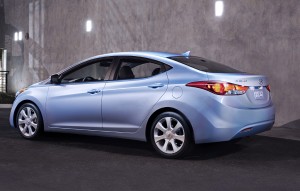
With products like the Elantra flying out the door, Hyundai (and sibling Kia) had the lowest industry incentives last month - but also the lowest average transaction prices.
Trend or just a temporary setback? In recent months, buyers have been steadily moving up-market while also adding significantly more content to the vehicles they buy. Along with cutbacks in the typical industry incentive package that has rapidly driven up the price motorists pay – the average transaction price, or ATP, in industry lingo.
But while January saw a surge in sales, preliminary data suggest they may also be reining in their spending by focusing on lower-priced, less lavishly-equipped models.
Including cars, light trucks and crossovers, the typical motorist spent $30,512 in January, according to car pricing information tracked by TrueCar.com, a 0.6% decline from December. But while that’s a notably reversal of recent trends, it doesn’t appear to signal an end to the industry’s current upward momentum, analysts stress.
For one thing, overall car sales were up substantially more than initial estimates had foreseen. And transaction prices were still about $1,731 – or 6.0% — above where they were a year ago.
“Transaction prices declined in January due to seasonality, attributed to a higher percentage of sales of SUVs and luxury vehicles the previous month,” said Jesse Toprak, VP of Industry Trends and Insights for TrueCar.com. “The consumer trend of valuing highly-equipped vehicles continued this month, generating higher transaction prices.”
The December to January downturn was felt across the board, impacting all the leading mainstream U.S., Japanese, Korean and European brands. But they all were up sharply, as well, when the latest month’s figures were compared to prices in January 2011.
The biggest increase there came from Hyundai and Kia, at an average 8.6%. But the traditionally value-oriented Koreans also had the lowest average transaction price in January of this year, at a modest $21,339. By comparison, the typical GM vehicle went for $32,971, while Toyotas – including both Lexus and Scion brands – averaged $27,258. The most expensive models, on average, were sold at Volkswagen dealerships, where the ATP hit $33,096 last month.
While transaction prices offer insight into how strong demand is for a manufacturer – and how they’re able to boost margins, an equally telling story can be told by the industry incentive data. And there the trend has been steadily downward. That’s no surprise considering that with sales surging, many makers are now struggling to keep up with demand, especially for their most popular products.
Strong sales typically mean manufacturers cut back on the cash piled up on a vehicle’s hood.
On average, carmakers gave back $2,592 in the form of rebates, low-interest loans and other incentives in January 2012, down 4.0% from January, though up a slight 0.5% from a year earlier.
At an estimated $1,027 a vehicle, Hyundai offered less than half the industry average – reflecting the maker’s increasing struggle to meet booming demand. Hyundai Motor America CEO John Krafcik recently warned TheDetroitBurea.com that the maker would likely have to slow its sales growth in the U.S. in 2012 because it is reaching the limits of its production capacity. (For more, Click Here.)
Hyundai incentives were actually up about 6% from December but were down more than 25% from a year ago.
The biggest jump from January 2011 came at Ford, where incentives rose 22.2% over the last 12 months, on average.
Chrysler had the biggest year-over-year decline – but at $3,233 it still gave out the largest incentives in January 2012. Other than the Koreans, Toyota had the lowest average giveback, according to TrueCar, at $1.921.
